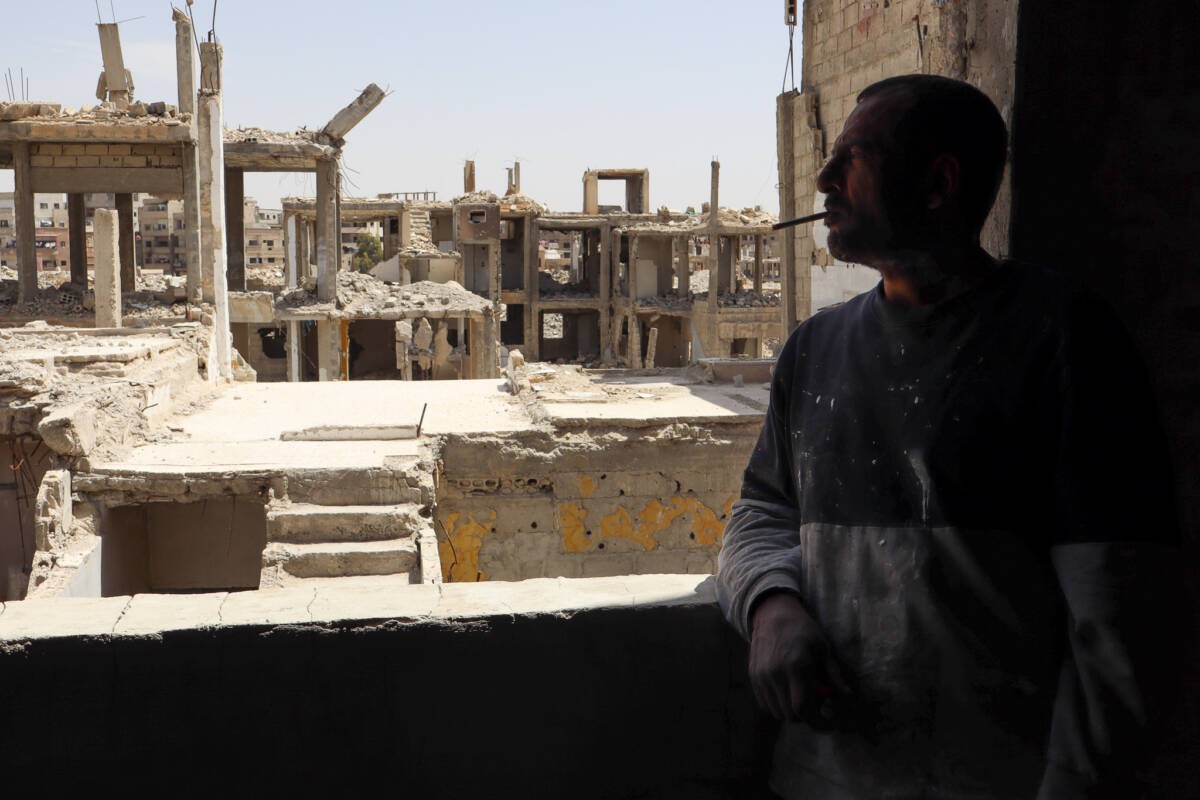YARMOUK CAMP — Hassan Tamim, 52, stood at the window of his third-floor apartment in the Syrian capital’s Yarmouk refugee camp–known as “Little Palestine”–looking at the skeletons of the buildings outside. The room he stood in was intact but barren, stripped to its concrete shell.
Like most homes in what was once Syria’s largest Palestinian refugee community, Tamim’s apartment was looted by Assad regime forces after they took control of the camp in 2018, following massive aerial and ground bombardment that destroyed up to 80 percent of its buildings.
“The 4th Division stole the iron and copper electrical wiring, the railings, the windows—everything,” Tamim told Syria Direct. “They took it and sold it.”
Tamim is one of at least 15,300 people currently living in Yarmouk, 80 percent of whom are Palestinian like him, according to the United Nations Relief and Works Agency (UNRWA). Before the war, around 1.2 million people lived in Yarmouk and the surrounding area, including 160,000 Palestinians.
In what was once considered the capital of the Palestinian diaspora, those who have returned to Yarmouk since the Assad regime fell last December are doing what they can to rebuild their lives. In stripped apartments and bombed-out buildings, most can only afford to make minor repairs. Little support has come from the state, UNRWA or other international organizations.
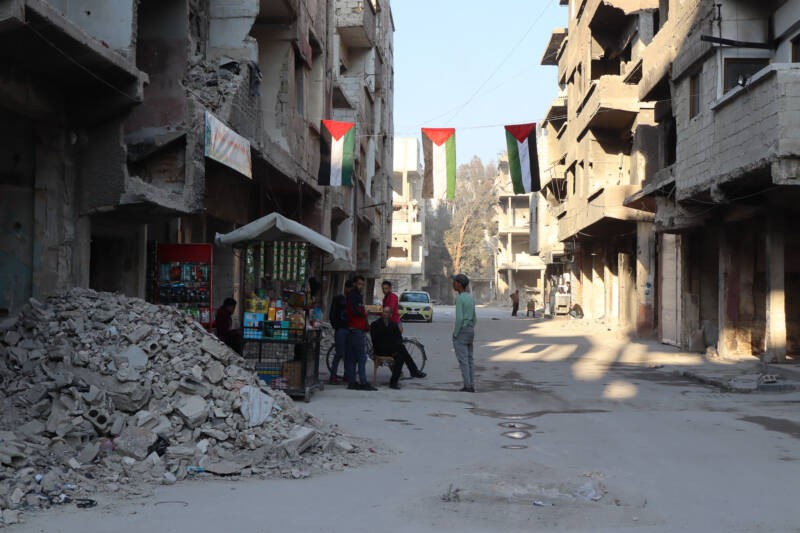
A small shop sells basic food items amid the rubble of damaged buildings in the Yarmouk camp in southern Damascus, 30/4/2025 (Natacha Danon/Syria Direct)
Basic repairs
Tamim fled Yarmouk with his family in 2012 and rented a home in Qudsaya on the northwest edge of Damascus. His brother, who stayed and fought with opposition forces in the camp, was killed during the war.
For years, even after the regime retook Yarmouk in 2018, it was difficult for Tamim to enter the camp. “You had to pay for security approval,” he recalled. Once, “we entered and found the Revolutionary Guard and 4th Division. There was a captain occupying our place. We told him this is our home, and he said: ‘get lost or I’ll shoot you.’”
When Syria Direct met Tamim, his wife, four children and 75-year-old grandmother were still living in Qudsaya while he worked to make their apartment in Yarmouk livable again. He had a lot of work ahead of him.
After returning to Yarmouk in December 2024, he repaired his apartment’s sewage pipes and electricity wiring at a cost of 60-70 million Syrian pounds (SYP) ($600-700). He estimated he needed SYP 15 million ($150) more to finish the repairs—a significant amount on top of the rent for the apartment back in Qudsaya. “I’ve deprived my children of clothing and food because I have to pay rent,” he said.
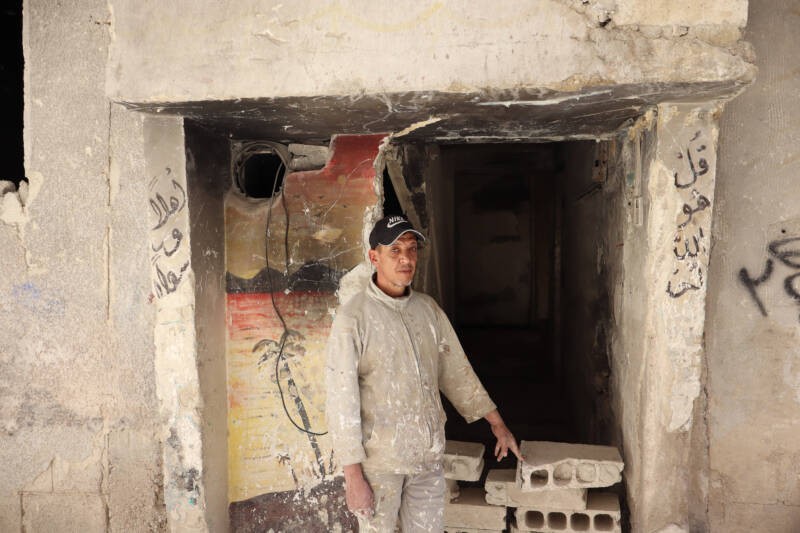
Amin Saeed Hafez, 52, stands at the entrance of his home in Yarmouk camp’s Magharebeh neighborhood. Before installing a door, he blocked the entrance with cinderblocks to keep stray dogs out of the building, 30/4/2025 (Natacha Danon/Syria Direct)
A few blocks away, Amin Saeed Hafez, 50, was also repairing his home, which he returned to after the regime fell. Due to heavy bombardment, only the ground floor remains of his two-floor building, which was also looted by regime forces. “The sewage [system] is completely broken—they broke it and took the pipes. There is no water,” he said.
As a painter earning meager wages, most of his income goes to renting an apartment elsewhere in Yarmouk. Repairing his own home would mean saving on rent. His first step was to install a door, which he went $200 into debt to purchase. In the meantime, he stacked cinder blocks in the entrance to keep out stray dogs.
If Hafez could put enough money aside to pay for the remaining repairs, he planned to move back into his home within a few months. When Syria Direct spoke to him, he did not “have any [money] except for this door,” he said. “I’m broke. If I don’t work, I don’t eat.”
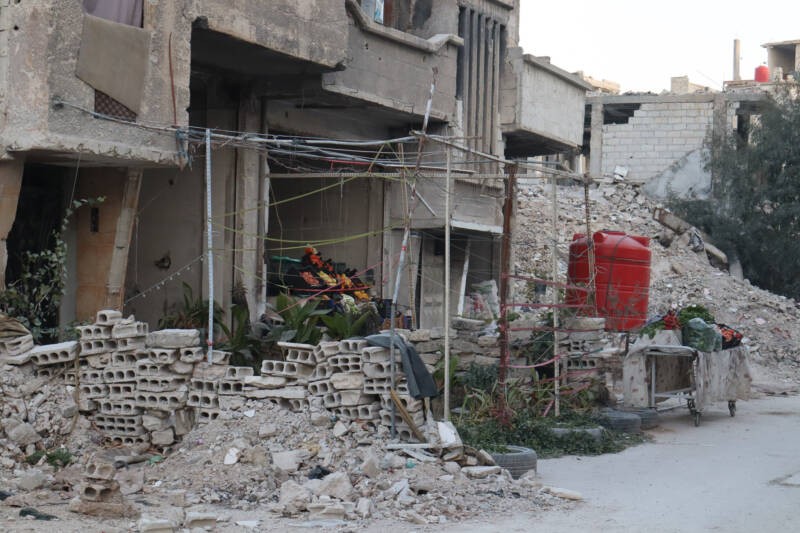
A store tucked into the rubble in Yarmouk sells vegetables and drinking water to the camp’s residents, 30/4/2025 (Natacha Danon/Syria Direct)
A 10-minute walk away, Zahir Klash, 41, lives on the ground floor of the damaged building she owns in Yarmouk. She sold her family jewelry for SYP 12 million ($120) to fund repairs, installing a solar panel and renovating the ground floor, but the apartments above are stripped bare and need extensive work.
“They burned the house, they burned the walls…they stole everything: sinks, tiles, windows, everything,” she said. “When I returned, my situation was very difficult…I became depressed and was very exhausted. The children cry, they need some time,” she added. Klash has developed asthma, which she believes is due to the dust and debris in the camp.
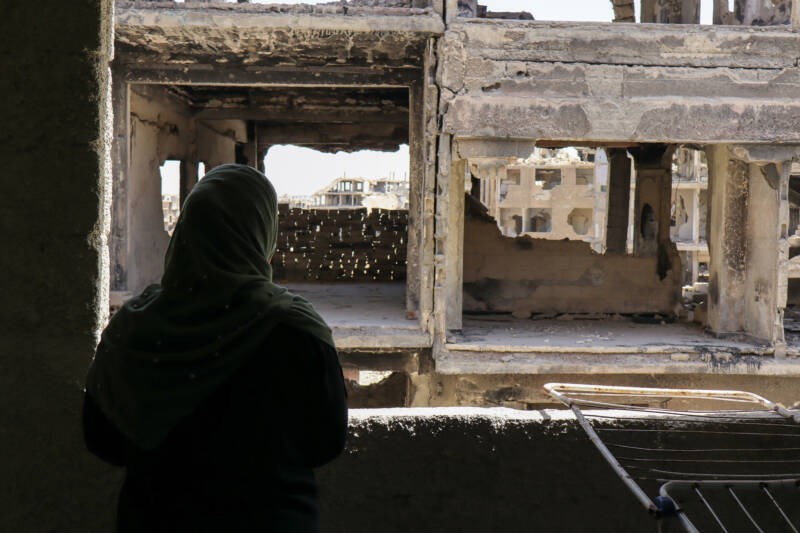
Zahir Klash, 41, looks out from the window of her home, 30/4/2025 (Natacha Danon/Syria Direct)
Without permits
Most of the repairs residents like Tamim, Hafez and Klash can afford are relatively minor, and they have not sought out safety assessments or municipal permits—either because they do not believe they are necessary, or because they cannot afford the related costs.
Many buildings in Yarmouk are at risk of collapse, with damage levels among the highest in the capital and greater Damascus area. “Yesterday, a building collapsed close to our home,” Klash told Syria Direct via WhatsApp in late June. “One fears for the children while they’re playing.”
Around the same time, in the al-Jazmati neighborhood of east Aleppo—another badly destroyed and formerly besieged opposition area—a balcony under construction collapsed, killing one young man and injuring three laborers. Recent years have seen multiple buildings collapse due to damage related to the war or the February 2023 earthquake in northern Syria.
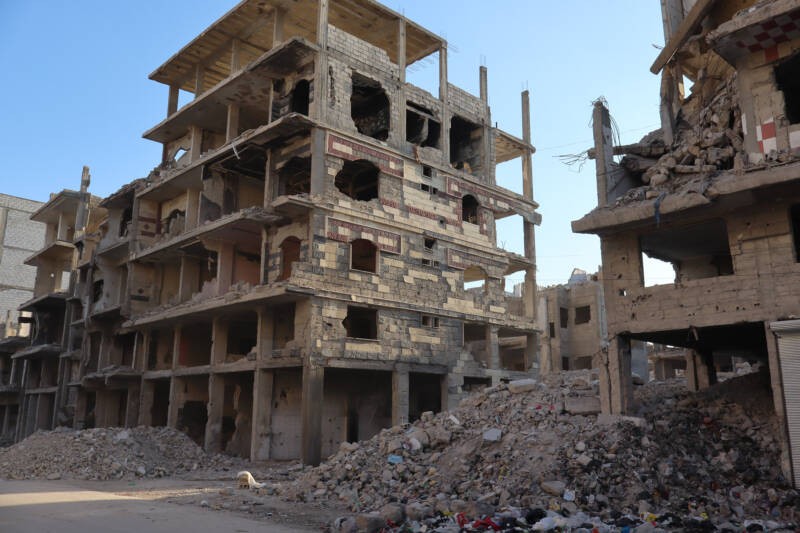
Damaged buildings in Yarmouk camp, 30/4/2025 (Natacha Danon/Syria Direct)
The Yarmouk municipality requires all residents to obtain approval to repair or rebuild their homes. To do so, residents must present a safety assessment from a certified engineer, as well as proof of ownership.
Besides the safety risks, “there is a risk of property issues without records,” municipal chief Ghada Shawiki told Syria Direct. “Any repairs require permits so we can check ownership, while the municipality does not give permits for destroyed [homes] that are leveled.”
Shawiki estimates that less than half of returnees have applied for permits due to lack of awareness or lack of funds to pay for an assessment.
“Anyone with money is repairing without approval,” Hafez said. He believed only full reconstruction required a permit, but could not afford to pay a certified engineer in any case. Tamim also believed only homes that were “leveled” required a permit from the municipality.
Klash had a safety assessment conducted by government engineers before the Assad regime fell, but similarly has not applied for a permit. An engineer from UNRWA also visited her home, she said.
“Last year an engineer from the UNRWA came to our home and took pictures of the upper floors and told us ‘we’re collecting statistics.’ But they didn’t say anything about [support for] restoration at all.”
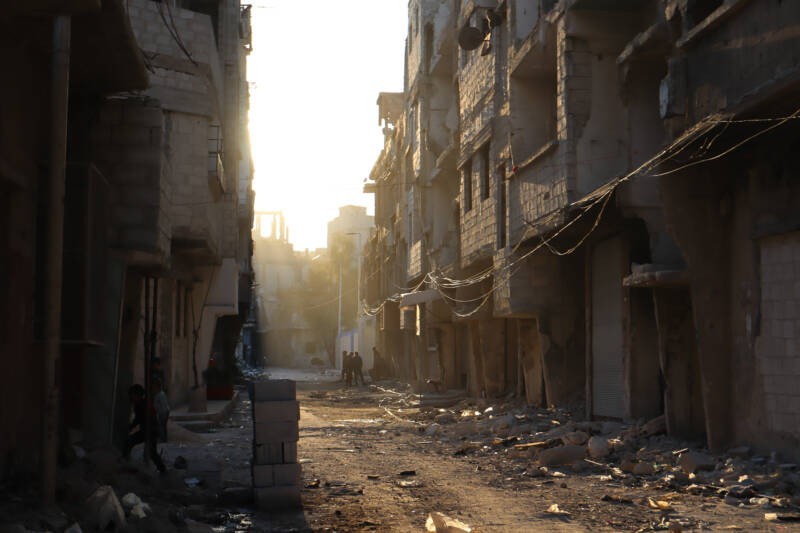
A group of boys gather in a side street of Yarmouk camp at sunset, 30/4/2025 (Natacha Danon/Syria Direct)
While the municipality says it requires permits for any repairs, an UNRWA spokesperson told Syria Direct permits were only needed for “destroyed buildings whose owners can afford reconstruction.”
“The Yarmouk Services Directorate requires an assessment report and approval from the engineering syndicate, costing approximately SYP 2 million ($200). Residents of Yarmouk receive a 50 percent discount, reducing the cost to around SYP 1 million ($100),” the spokesperson added.
UNRWA’s support for Yarmouk residents is currently limited to cash assistance for “minor shelter repairs for structurally sound homes,” the agency said. “To date, no donor has expressed interest in supporting large-scale reconstruction.” In all, 320 households have benefited from UNRWA assistance for repairs, with another 500-600 in the pipeline.
But most returned residents feel they are on their own, and are taking matters into their own hands as they are able. “To get assistance from UNRWA you need connections,” Hafez said.
